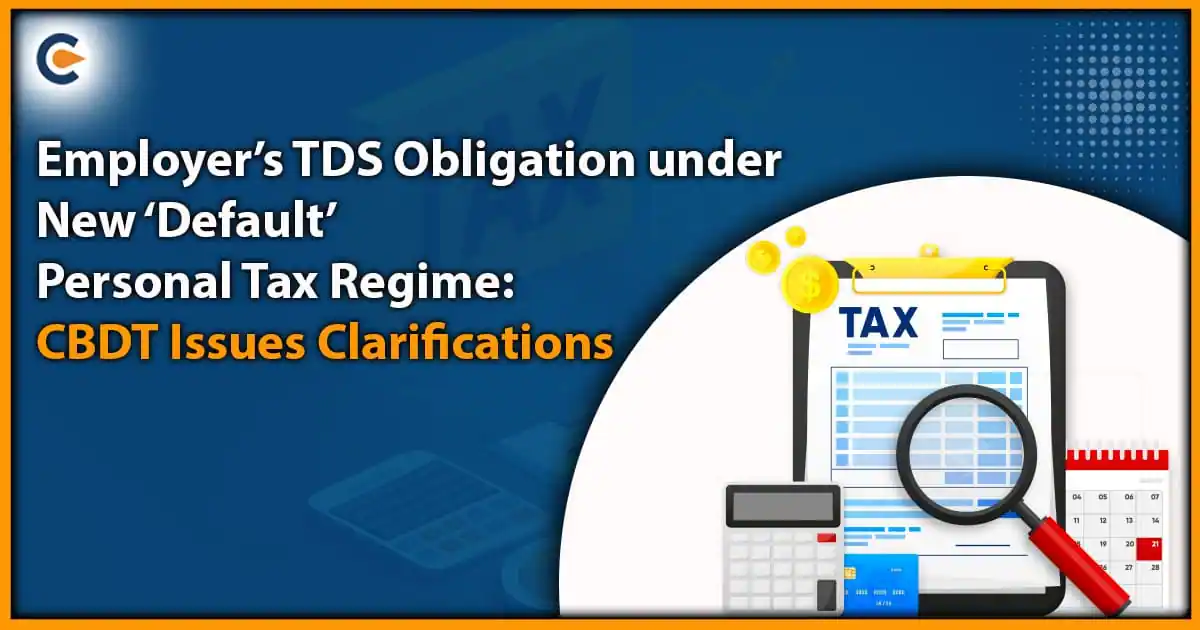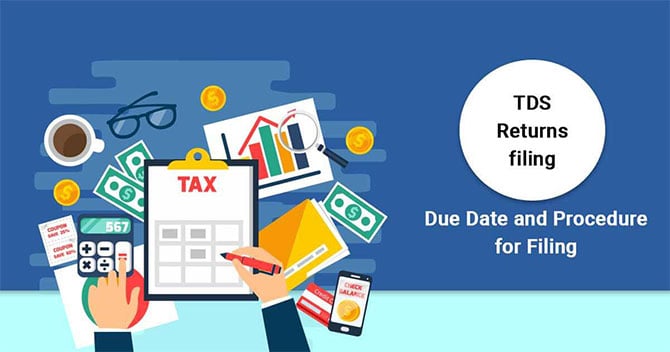The Central Board of Direct Taxes (CBDT) recently issued a set of clarifications regarding the employer’s Tax Deducted at Source (TDS) obligations under the new ‘Default’ Personal Tax Regime. With the implementation of the new tax regime, several changes have been introduced, leading to confusion among employers. In this blog post, we will explore the key clarifications provided by the CBDT, helping employers understand their TDS obligations more effectively.
The new ‘Default’ Personal Tax Regime was introduced to simplify the income tax structure for individual taxpayers. It offers lower tax rates, eliminating various deductions and exemptions available under the previous tax regime. Taxpayers have the option to choose between the new ‘Default’ regime and the existing tax regime with deductions and exemptions (referred to as the ‘Old’ regime). Employers play a crucial role in deducting TDS on employee salaries based on the applicable tax regime. The introduction of the new ‘Default’ regime has raised concerns among employers regarding their TDS obligations.
With the recent clarifications issued by the CBDT, employers can gain clarity on their TDS obligations and ensure compliance with the new tax regime. In the following sections, we will delve into the specific clarifications provided by the CBDT, enabling employers to navigate the TDS requirements smoothly and accurately.
Overview of the New ‘Default’ Personal Tax Regime
Understanding the Changes
The introduction of the new ‘Default’ Personal Tax Regime has brought significant changes to the income tax structure for individual taxpayers. It aims to simplify the tax system by offering lower tax rates while eliminating various deductions and exemptions available under the previous regime. Understanding these changes is crucial for both taxpayers and employers, particularly regarding TDS obligations.
Under the new ‘Default’ regime, taxpayers have the option to choose between this regime and the existing ‘Old’ regime that allows for deductions and exemptions. The ‘Default’ regime offers lower tax rates, making it an attractive choice for many individuals. However, this change has implications for employers responsible for deducting TDS from employee salaries. To navigate the new tax landscape, it is essential to comprehend the changes introduced by the ‘Default’ Personal Tax Regime. This understanding will enable employers to fulfill their TDS obligations accurately and in compliance with the CBDT’s guidelines. In the subsequent sections, we will explore the key clarifications provided by the CBDT, shedding light on the employer’s TDS obligations under the new regime.
Impact on Employers
The implementation of the new ‘Default’ Personal Tax Regime has significant implications for employers, particularly concerning their TDS obligations. Here are some key impacts that employers need to be aware of:
- Revised TDS Rates: With the new tax regime, the TDS rates have undergone changes. Employers must update their payroll systems to incorporate the revised rates accurately. This ensures that TDS deductions from employee salaries align with the tax rates specified under the ‘Default’ regime.
- Elimination of Deductions and Exemptions: The ‘Default’ regime eliminates various deductions and exemptions that were available under the previous tax regime. Employers must ensure that TDS calculations are based on the revised taxable income, considering the absence of these deductions and exemptions.
- Reconciliation of TDS Deductions: Employers need to reconcile TDS deductions made for employees who have chosen either the ‘Default’ or ‘Old’ regime. The CBDT has directed employers to provide a separate breakup of TDS deductions for employees under both regimes in the Form 16, the salary certificate issued by employers. This allows for proper reporting and compliance with the tax regulations.
- Employee Communication: Employers play a crucial role in communicating the changes brought about by the new tax regime to their employees. They need to educate employees about the implications of choosing the ‘Default’ or ‘Old’ regime on their TDS deductions and tax liability. Clear communication helps employees make informed decisions and minimizes any confusion or misunderstandings.
- Compliance and Reporting: Employers must ensure timely and accurate filing of TDS returns, reflecting the deductions made under the applicable tax regime. Compliance with the due dates specified by the Income Tax Act is essential to avoid penalties and maintain good tax governance.
By understanding the impact of the new ‘Default’ Personal Tax Regime on their TDS obligations, employers can adapt their processes and systems accordingly. This ensures smooth compliance and effective management of TDS deductions for their employees. In the next sections, we will delve into the clarifications provided by the CBDT, shedding light on the specific obligations and guidelines for employers in the context of TDS deductions.
Clarifications on Employer’s TDS Obligations
TDS Deduction for Employees Opting for the ‘Default’ Regime
The Central Board of Direct Taxes (CBDT) has provided important clarifications regarding the TDS obligations of employers for employees who have opted for the ‘Default’ Personal Tax Regime. Here are the key clarifications:
- Tax Liability Calculation: Employers should calculate the tax liability of employees who have chosen the ‘Default’ regime based on the prescribed tax rates for this regime. The TDS deductions should align with these rates, ensuring accurate withholding of taxes from employee salaries.
- Exemptions and Deductions: Under the ‘Default’ regime, several exemptions and deductions available in the ‘Old’ regime are not applicable. Employers must ensure that TDS calculations consider the absence of these exemptions and deductions, resulting in a higher taxable income for employees.
- Updated Payroll Systems: Employers need to update their payroll systems and software to incorporate the revised tax rates and provisions of the ‘Default’ regime. This ensures accurate TDS calculation and withholding from employee salaries, reducing the risk of non-compliance.
- Form 16 Reporting: Employers are required to provide a separate breakup of TDS deductions for employees who have chosen the ‘Default’ regime in the Form 16. This facilitates proper reporting and helps employees reconcile their tax liabilities while filing their income tax returns.
By following these clarifications, employers can ensure that TDS deductions for employees opting for the ‘Default’ regime are done accurately and in compliance with the CBDT’s guidelines. In the subsequent sections, we will explore further clarifications provided by the CBDT, focusing on the TDS deductions for employees who have opted for the ‘Old’ regime.
TDS Deduction for Employees Opting for the ‘Old’ Regime
The Central Board of Direct Taxes (CBDT) has also issued clarifications regarding the TDS obligations of employers for employees who have chosen the ‘Old’ Personal Tax Regime. Here are the key clarifications:
- TDS Calculation: Employers should continue to deduct TDS for employees who have opted for the ‘Old’ regime based on the tax rates applicable to this regime. The existing provisions related to TDS deductions, including exemptions and deductions specified under the Income Tax Act, should be considered while calculating TDS.
- Deductions and Exemptions: Unlike the ‘Default’ regime, the ‘Old’ regime allows for various deductions and exemptions. Employers should take into account these deductions and exemptions while calculating TDS for employees who have opted for this regime. This ensures that TDS deductions align with the taxable income after considering the available benefits.
- Form 16 Reporting: Similar to employees in the ‘Default’ regime, employers must provide a separate breakup of TDS deductions for employees who have chosen the ‘Old’ regime in the Form 16. This allows for accurate reporting and enables employees to reconcile their tax liabilities while filing their income tax returns.
Employers must ensure that their payroll systems and software are updated to handle TDS deductions accurately for employees in the ‘Old’ regime. Adhering to the CBDT’s clarifications will help employers fulfil their TDS obligations correctly and in line with the applicable tax regulations. In the next sections, we will discuss additional aspects of the employer’s TDS obligations and provide insights into the reconciliation of TDS deductions and the importance of timely filing of TDS returns.
Reconciliation of TDS Deductions
The Central Board of Direct Taxes (CBDT) emphasizes the importance of reconciling Tax Deducted at Source (TDS) deductions made for employees under both the ‘Default’ and ‘Old’ Personal Tax Regimes. Here are the key points regarding the reconciliation process:
- Separate Breakup: Employers are required to provide a separate breakup of TDS deductions for employees who have chosen either the ‘Default’ or ‘Old’ regime. This separation allows for proper tracking and reporting of TDS deductions made under each regime.
- Form 16: The Form 16, the salary certificate issued by employers, should include the detailed breakup of TDS deductions for employees under both tax regimes. This ensures transparency and assists employees in accurately reporting their income and tax liabilities while filing their income tax returns.
- Compliance Check: Employers should conduct regular compliance checks to ensure that TDS deductions are correctly accounted for and reconciled. This involves verifying the accuracy of TDS calculations, cross-checking the breakup of deductions for employees in each regime, and rectifying any discrepancies promptly.
- Audit Trail: Maintaining an audit trail of TDS deductions and reconciliations is crucial for compliance purposes. Employers should keep records of TDS calculations, supporting documentation, and reconciliation statements to provide an accurate account of the deductions made for each employee.
Reconciling TDS deductions is essential to maintain accurate tax records, ensure compliance with the CBDT’s guidelines, and avoid any discrepancies or penalties. By adhering to the reconciliation process outlined by the CBDT, employers can maintain proper records and transparency in TDS deductions under the ‘Default’ and ‘Old’ regimes.
In the following sections, we will discuss the significance of timely filing of TDS returns and the importance of implementing accurate TDS calculation processes to meet the employer’s TDS obligations effectively.
Implementation and Compliance
Timely Filing of TDS Returns
Timely filing of Tax Deducted at Source (TDS) returns is crucial for employers to meet their obligations and comply with the Income Tax Act. Here are the key points to consider regarding the timely filing of TDS returns:
- Due Dates: Employers must adhere to the due dates specified by the Income Tax Act for filing TDS returns. These due dates may vary depending on the type of deductor and the nature of payments. It is essential to stay updated with the latest due dates to avoid any penalties or consequences for late filing.
- Form 24Q and Form 26Q: Employers need to file TDS returns using Form 24Q for salaries and Form 26Q for non-salary payments. These forms capture the details of TDS deductions made from employee salaries and other payments to be reported to the Income Tax Department.
- Accurate Reporting: Employers should ensure the accuracy of the information reported in the TDS returns, including the breakup of TDS deductions for employees under both the ‘Default’ and ‘Old’ regimes. Cross-verify the data to avoid any errors or discrepancies that may arise during the filing process.
- Digital Filing: The Income Tax Department promotes the electronic filing of TDS returns through the Tax Information Network (TIN) or the e-Filing portal. Employers should utilize these digital platforms for convenient and efficient submission of TDS returns within the specified timelines.
- Compliance Checks: Conduct periodic compliance checks to ensure that TDS returns are filed accurately and on time. This includes verifying the completeness of data, reconciliation of TDS deductions, and rectifying any errors or inconsistencies promptly.
Timely filing of TDS returns demonstrates compliance with the tax regulations and facilitates smooth communication between employers and the Income Tax Department. By understanding the due dates, using the appropriate forms, ensuring accurate reporting, and leveraging digital filing platforms, employers can fulfill their TDS obligations effectively.
In the next section, we will discuss the importance of accurate TDS calculations and the need for employers to update their payroll systems to comply with the revised tax rates and provisions of the ‘Default’ and ‘Old’ Personal Tax Regimes.
Ensuring Accurate Calculation of TDS
Accurate calculation of Tax Deducted at Source (TDS) is crucial for employers to fulfill their obligations and comply with the tax regulations. Here are the key considerations for ensuring accurate TDS calculations:
- Updated Payroll Systems: Employers need to update their payroll systems and software to incorporate the revised tax rates and provisions of both the ‘Default’ and ‘Old’ Personal Tax Regimes. This ensures that TDS deductions align with the applicable tax rates and exemptions, avoiding any miscalculations or discrepancies.
- Knowledge of Tax Rules: Employers should have a thorough understanding of the tax rules and provisions related to TDS calculations. This includes being aware of the exemptions, deductions, and applicable tax rates under each tax regime. Regular updates and training for the payroll team can help maintain accurate TDS calculations.
- Verification of Employee Declarations: Employers should verify the accuracy of the employee declarations regarding their chosen tax regime, exemptions, and deductions. This helps ensure that the TDS deductions are calculated correctly based on the information provided by employees.
- Cross-Checking TDS Deductions: Employers should regularly cross-check the TDS deductions made for employees against the calculated amounts. This verification process helps identify any errors or discrepancies and enables prompt rectification.
- Periodic Review: Employers should conduct periodic reviews of their TDS calculation processes to ensure accuracy and compliance. This includes reviewing the methodology used for TDS calculations, documentation, and internal controls to minimize errors and maintain consistency.
Accurate TDS calculations not only fulfill the employer’s obligations but also contribute to the smooth income tax filing process for employees. By updating payroll systems, staying knowledgeable about tax rules, verifying employee declarations, cross-checking deductions, and conducting periodic reviews, employers can ensure the precision of their TDS calculations.
In the concluding section, we will summarize the key clarifications provided by the CBDT and emphasize the importance of employers’ compliance with the TDS obligations under the new ‘Default’ Personal Tax Regime.
Conclusion
In conclusion, the clarifications issued by the CBDT regarding the employer’s TDS obligations under the new ‘Default’ Personal Tax Regime have shed light on key considerations and guidelines. Employers must ensure accurate TDS calculations, update their payroll systems, reconcile TDS deductions, and file TDS returns on time to comply with the tax regulations. By adhering to these obligations, employers can effectively manage TDS deductions for employees who have opted for the ‘Default’ or ‘Old’ regime. Accurate TDS calculations, proper reporting in the Form 16, and timely filing of TDS returns contribute to a transparent and compliant tax process. It is essential for employers to stay informed about any further updates or changes in the tax regulations and consult with tax professionals if needed. By proactively staying up-to-date and implementing the necessary measures, employers can fulfill their TDS obligations confidently and contribute to a smooth tax environment for both employers and employees.
Read our Article: A Complete Guide To Understanding Professional Tax In India











